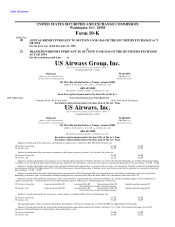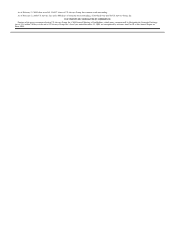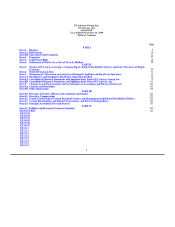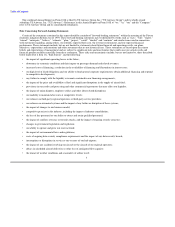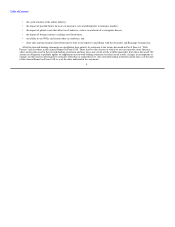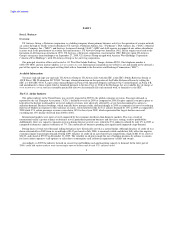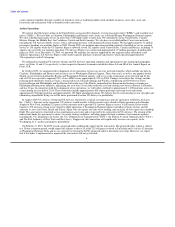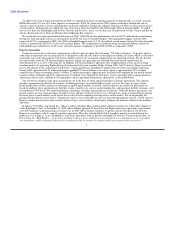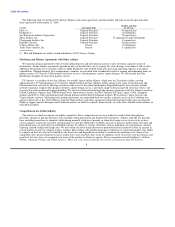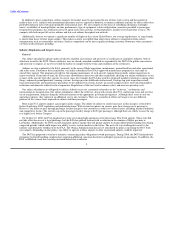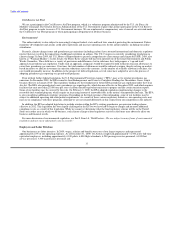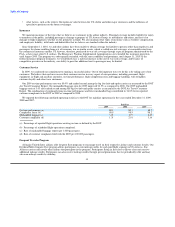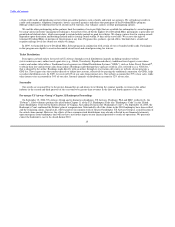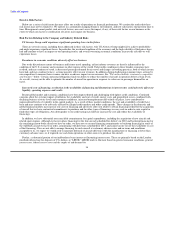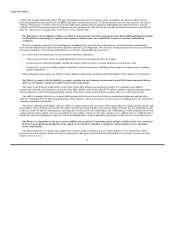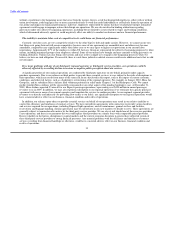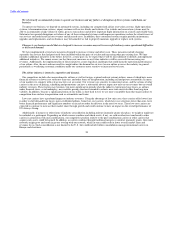US Airways 2009 Annual Report Download - page 12
Download and view the complete annual report
Please find page 12 of the 2009 US Airways annual report below. You can navigate through the pages in the report by either clicking on the pages listed below, or by using the keyword search tool below to find specific information within the annual report.
Table of Contents
the issuance of a final report suggesting model contingency plans for long on-board delays. Contemporaneous with the end of the task
force, the DOT issued proposed rules that would place additional requirements on airlines concerning service irregularities, consumer
rights and contract of carriage obligations. These new rules were recently finalized by the DOT and take effect in April 2010. While we
are preparing for the implementation of these new rules, we are still evaluating what the full impact of these rules will be on our
operations.
Additional laws, regulations, taxes and policies have been proposed or discussed from time to time, including recently introduced
federal legislation on a "passenger bill of rights," that, if adopted, could significantly further increase the cost of airline operations or
reduce revenues.
The DOT allows local airport authorities to implement procedures designed to abate special noise problems, provided such procedures
do not unreasonably interfere with interstate or foreign commerce or the national transportation system. Certain locales, including Boston,
Washington D.C., Chicago, San Diego and San Francisco, among others, have established airport restrictions to limit noise, including
restrictions on aircraft types to be used and limits on the number of hourly or daily operations or the time of these operations. In some
instances, these restrictions have caused curtailments in service or increases in operating costs, and these restrictions could limit the
ability of our airline subsidiaries to expand their operations at the affected airports. Authorities at other airports may adopt similar noise
regulations.
International
The availability of international routes to domestic air carriers is regulated by agreements between the U.S. and foreign governments.
Changes in U.S. or foreign government aviation policy could result in the alteration or termination of these agreements and affect our
international operations. We could continue to see significant changes in terms of air service between the United States and Europe as a
result of the implementation of the U.S. and the EU Air Transport Agreement, generally referred to as the Open Skies Agreement, which
took effect in March 2008. The Open Skies Agreement removes bilateral restrictions on the number of flights between the U.S. and EU.
One result of the Open Skies Agreements has been applications before the DOT for antitrust immunity between various domestic and
international airlines. If granted, antitrust immunity permits carriers to coordinate schedules, pricing and other competitive aspects on
international routes to/from the United States. It is possible that the grant of these immunities could have an impact on our international
operations.
Security
The Aviation and Transportation Security Act (the "Aviation Security Act") was enacted in November 2001. Under the Aviation
Security Act, substantially all aspects of civil aviation security screening were federalized, and a new Transportation Security
Administration (the "TSA") under the DOT was created. The TSA was then transferred to the Department of Homeland Security pursuant
to the Homeland Security Act of 2002. The Aviation Security Act, among other matters, mandates improved flight deck security; carriage
at no charge of federal air marshals; enhanced security screening of passengers, baggage, cargo, mail, employees and vendors; enhanced
security training; fingerprint-based background checks of all employees and vendor employees with access to secure areas of airports
pursuant to regulations issued in connection with the Aviation Security Act; and the provision of certain passenger data to U.S. Customs
and Border Protection.
Funding for the TSA is provided by a combination of air carrier fees, passenger fees and taxpayer monies. A "passenger security fee,"
which is collected by air carriers from their passengers, is currently set at a rate of $2.50 per flight segment but not more than $10 per
round trip. An air carrier fee, or Aviation Security Infrastructure Fee ("ASIF"), has also been imposed with an annual cap equivalent to
the amount that an individual air carrier paid in calendar year 2000 for the screening of passengers and property. The TSA may lift this
cap at any time and set a new higher fee for air carriers.
In 2009, we incurred expenses of $53 million for the ASIF, including amounts paid by our wholly owned regional subsidiaries, PSA
and Piedmont, and amounts attributable to the other regional carriers. Implementation of and compliance with the requirements of the
Aviation Security Act have resulted and will continue to result in increased costs for us and our passengers and has and will likely
continue to result in service disruptions and delays. As a result of competitive pressure, US Airways and other airlines may be unable to
recover all of these additional security costs from passengers through increased fares. In addition, we cannot forecast what new security
and safety requirements may be imposed in the future or the costs or financial impact of complying with any such requirements.
10


